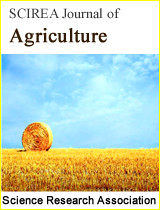Colorado River: Solutions for better use and Environmental Protection.
DOI: 10.54647/agriculture21189 186 Downloads 14644 Views
Author(s)
Abstract
The Colorado River, with a distance of over 2,300 kilometers, is one of rivers that present greater conflict between its states users, who have had to live around water resources in order to achieve mutual benefits. It is observable all the Mexican side is frequently suffer the negative impacts in terms of allocations in terms of quantity and quality of water. Before the construction of large dams along its course; Colorado River fed one of the largest desert estuaries in the world. Located on the northern edge of the Gulf of California, vast freshwater wetlands, once covered 780,000 ha (1 930,000 acres) and hosted a legendary wealth of plants, birds and human life.
After nearly five decades of inactivity, the currents flow again on the Colorado River, On March 23, 2014, thanks to the treaty "Pulse flow" in "minute 319", 105,000-acre-foot , (130 million cubic meters) a very positive event, the result of long negotiations between Mexico and the United States. The pulse flow experiment is expected to flood low terraces and backwaters, move sediment, elevate the water table, and promote the germination of cottonwood and willow tree.
In another case, the administration of the Irrigation District Mexicali Valley.
Planning is required in the distribution of water to farmers in the Mexicali Valley; working together in the case of a single river between the two districts of Imperial Valley and Mexicali Valley.
Work should be done together while the Colorado River is our only source of water for human consumption and agricultural production, which requires the use and knowledge management, through good management practices of irrigation water and fertilizer. Use surface water drainage that meets the classification according to the classification of irrigation water can recycled for use of irrigation water.
The increased values of environmental quality and habitat throughout the basin, so that the river bed to recover, and prevent the loss of endemic species. Change some habits they have and thus reduce the consumption of the liquid.
Keywords
Irrigation District, Drought, minute 319, pulse flow.
Cite this paper
María I. Escobosa, Fidel Núñez, Víctor A. Cárdenas, Roberto Soto Ortiz, S. Mónica Avilés, Aurelia Mendoza,
Colorado River: Solutions for better use and Environmental Protection.
, SCIREA Journal of Agriculture.
Volume 6, Issue 1, February 2021 | PP. 1-9.
10.54647/agriculture21189
References
| [ 1 ] | Calleros, Jesus Adolfo. 2014. EL ACTA 319 de CILA: Estrategia Binacional ante la Sequía. Congress in Tempe, Arizona. |
| [ 2 ] | Bali, K.M., M.E. Grismer y I.C. Tod. 2001. Reduced Runoff Irrigation of Alfalfain Imperial Valley, California Journal of Irrigation and Drainage Engineerin/May/June 2001/ pp 123-130 |
| [ 3 ] | Escobosa, M.I., Bali, K.M., Guerrero, Juan., Soto O. R., Escoboza, L.F., Pérez M. A. Cárdenas S. V.2009. Efecto de la Calidad del Agua de Drenaje Superficial y su re-uso Mediante Practicas de Aplicacián de Fosforo en Alfalfa (Medicago sativa), en el Valle Imperial. Agrofaz, Marzo. ISSN: 1665-8892. Pp 49-56 |
| [ 4 ] | Grismer M.E. and Bali, K. M. 2001. Reduced Run-Runnof Irrigation of Sudan Grass Hay, Imperial Valley, California, American Society of Civil Enginneers, Journal of Irrig. & Drain. Engr. Vol 127. No. 5, pp. 319-323. |
| [ 5 ] | http://www.excelsior.com.mx/global/2015/04/02/1016685#imagen-2 |
| [ 6 ] | http://www.ibwc.gov/Files/Minutes/Minute_319.pdf |
| [ 7 ] | http://www.ibwc.gov/Files/Minutes/Min_318.pdf |
| [ 8 ] | Meybery, K.S., and Meister H. 2003. University of California Coorporative Extension. Cost of production, Field Crops. |
| [ 9 ] | Osvel Hinojosa y Yamilett Carrillo.2013. Atals, Las Cuencas Hidrogáficas de México. Cuenca binacional del Rio Colorado.pp. 180-185. |
| [ 10 ] | Wilhite, D.A. y Glantz, M.H. (1985). “Understanding the drougth phenomenon: the role of definitions” , Water international, vol 10: 111-120. |
| [ 11 ] | World Metereological Organization. 1992. Manual on the global data processing and forecasting system. |

